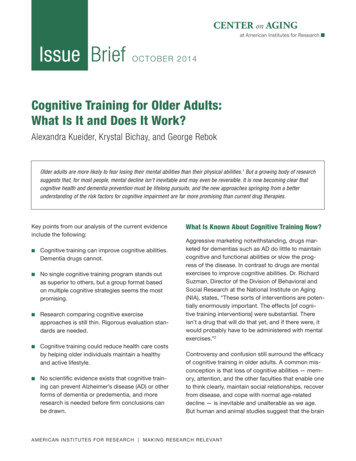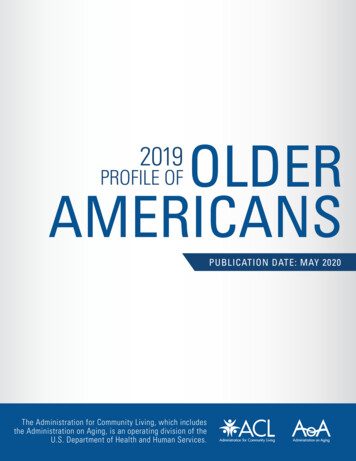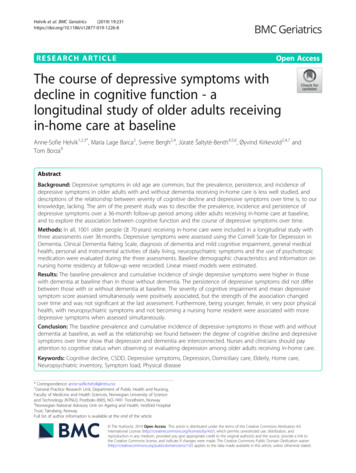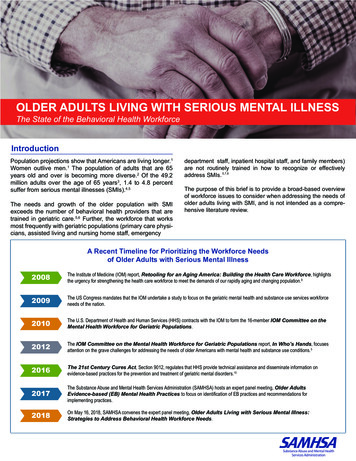
Transcription
Issue BriefO CTO B E R 2014Cognitive Training for Older Adults:What Is It and Does It Work?Alexandra Kueider, Krystal Bichay, and George RebokOlder adults are more likely to fear losing their mental abilities than their physical abilities.1 But a growing body of researchsuggests that, for most people, mental decline isn’t inevitable and may even be reversible. It is now becoming clear thatcognitive health and dementia prevention must be lifelong pursuits, and the new approaches springing from a betterunderstanding of the risk factors for cognitive impairment are far more promising than current drug therapies.Key points from our analysis of the current evidenceinclude the following: Cognitive training can improve cognitive abilities.Dementia drugs cannot. No single cognitive training program stands outas superior to others, but a group format basedon multiple cognitive strategies seems the mostpromising. Research comparing cognitive exerciseapproaches is still thin. Rigorous evaluation standards are needed. Cognitive training could reduce health care costsby helping older individuals maintain a healthyand active lifestyle. No scientific evidence exists that cognitive training can prevent Alzheimer’s disease (AD) or otherforms of dementia or predementia, and moreresearch is needed before firm conclusions canbe drawn.What Is Known About Cognitive Training Now?Aggressive marketing notwithstanding, drugs marketed for dementias such as AD do little to maintaincognitive and functional abilities or slow the progress of the disease. In contrast to drugs are mentalexercises to improve cognitive abilities. Dr. RichardSuzman, Director of the Division of Behavioral andSocial Research at the National Institute on Aging(NIA), states, “These sorts of interventions are potentially enormously important. The effects [of cognitive training interventions] were substantial. Thereisn’t a drug that will do that yet, and if there were, itwould probably have to be administered with mentalexercises.”2Controversy and confusion still surround the efficacyof cognitive training in older adults. A common misconception is that loss of cognitive abilities — memory, attention, and the other faculties that enable oneto think clearly, maintain social relationships, recoverfrom disease, and cope with normal age-relateddecline — is inevitable and unalterable as we age.But human and animal studies suggest that the brainA MERICAN INSTI TUTES FOR R ES EA R CH M A K I N G RE SE ARC H RE L E VAN T
ISSUE BRIEFis malleable, even late in life. Although no conclusiveevidence points to any particular cognitive training program as the most effective way to maintaincurrent cognitive abilities or delay dementia’s onset,participation in mentally stimulating activities isassociated with lowered risk for developing AD andrelated dementias.There is an urgent need to lower the risk of developing AD and related dementias quickly, effectively,and at a low cost. According to the NIA, 87 percentof individuals remain cognitively healthy well into oldage, while one in seven develop more severe cognitive impairments, including dementia.3 One in nineadults over the age of 65 has AD, and one in threeover the age of 85 has AD.4 And the aging populationis growing rapidly. In 2010, 40 million people aged65 and older accounted for 13 percent of the totalU.S. population. In 2030, the number of people in theUnited States over the age of 65 is expected to growto 72 million, accounting for almost 20 percent of theU.S. population.5What Is Cognition, and What Is CognitiveTraining?Cognition is a combination of processes, includingpaying attention, learning and reacting to objects inthe environment, and using language and memory.If cognition becomes impaired, an individual mayhave difficulty performing everyday tasks. If thosetasks become very hard or impossible to perform,AD or another type of dementia is diagnosed, inwhich case cognitive training may be in order. Thekey question here is whether training basic cognitiveabilities will transfer to everyday abilities, such asmanaging one’s finances or medicines.Cognitive training is based on the idea that the brain,even in old age, can change for the better. What weknow about the brain suggests that it resemblesmuscles: In the same way that physical trainingimproves physical abilities, cognitive training (orbrain training) improves cognitive (or mental) abilities. Cognitive training uses guided practice on aset of tasks related to memory, attention, or otherbrain functions. This training can take many shapes.For instance, it can be conducted on the computeror delivered in person, either individually or in smallgroups. But it typically involves using repetitiveexercises designed to improve single (e.g., memory)or multiple (e.g., memory and reasoning) cognitiveabilities.Cognitive training programs seem more likely towork if they are delivered in a group format, containmultiple cognitive strategies (e.g., the use of imageryto aid memory and repetition), and grow more challenging as performance improves.6 Table 1 comparessome cognitive training programs to cognitive stimulation and cognitive rehabilitation, all of which aim toincrease general cognitive and social function.Table 1. Three Approaches to Improve Cognitive AbilitiesCognitive TrainingCognitive StimulationCognitive RehabilitationDescriptionUses repetitive exercises keyed to specific Engagement with activities involving some mentalcognitive abilities. May be computer-asprocessing in a social context. Aims to be enjoyable.sisted or delivered in person individuallyor in small groups.Tailored to the individual and involvesworking on personal goals, often using external cognitive aids. Usually implementedin real-world settings.Example 1The ACTIVE study trained one of threeabilities:MemoryReasoningInformation processing speed7Experience Corps uses the time, skills, and experienceof older adult volunteers to improve the health and wellbeing of the volunteers and the educational outcomes ofdisadvantaged elementary-school children. Volunteersare trained for 30 hours in literacy support, violenceprevention and other skills.9A personalized memory notebook system,much like a Daytimer, is tailored to anindividual’s memory deficits. Sections mayinclude:Orientation (personal and medical info)Names of emergency contactsExample 2The IMPACT study used six computerizedexercises to improve the speed and accuracy of auditory information processing.8Senior Odyssey is a community-based intervention:older adults tackle a program of problem solving andbrain teasers. Teams meet weekly for 16 weeks to develop and test solutions for a long-term problem and topractice working as a group on spontaneous problems.10Rehabilitation may also cover specificeveryday tasks, such as making change orbalancing a checkbook.2
ISSUE BRIEFThroughout the past 15 years, cognitive traininginterventions have been used to improve cognitiveperformance in healthy older adults. To date, thelargest trial of cognitive training in cognitively healthyolder adults is the Advanced Cognitive Training forIndependent and Vital Elderly (ACTIVE) study. Itsparticipants were assigned to one of three intervention groups (i.e., memory, reasoning or informationprocessing speed) or to a no-contact control group.The memory training intervention aimed to create multiple ways to make the to-be-rememberedinformation more meaningful, such as rememberingit by categorizing, visualizing and associating it withsomething familiar or well-known. The reasoningtraining intervention aimed to improve the ability toidentify patterns from a series of letters, numbersand words that act as an aid to organizing dailyactivities, such as following a medication regimenand thus reducing the burden on memory. (If oneknows how to read a bus schedule, one doesn’thave to remember when the bus comes.) Theinformation processing speed training interventionaimed to improve mental processing speed so thatincreasingly complex information could be understood increasingly fast. How quickly could someone,for instance, identify whether an object in the middleof their visual field was a car or a truck while simultaneously noting where — in their peripheral field ofvision — another car was located.Results from the ACTIVE study showed that traininghad immediate and long-term effects lasting up tofive years on memory abilities11 and up to 10 yearson reasoning and information processing speed,12far longer, in both cases, than what is documentedfor other programs. Training also had real-worldeffects. Ten years after initial training, all three training groups reported less difficulty in the instrumental activities of daily living (e.g., medication management, meal preparation) than the control group,and at least 60 percent of participants in all trainedgroups continued to report less difficulty performing such activities after 10 years, compared to 49percent of nontrained participants. After 10 years,60 to 70 percent of participants said that they wereas good as or better than when they started theACTIVE study.“[ACTIVE] found that community-dwelling seniors who receivedcognitive training had less of a decline in certain thinking skillsthan [those] who did not have training. The study addresses avery important hypothesis — interventions can be designed tomaintain cognitive function.”- Richard J. Hodes, M.D., NIA DirectorCan the training effects of ACTIVE and other cognitive training trials be compared to the treatmenteffects of drug trials with dementia patients? Theshort answer is that it’s difficult. Both the primaryoutcome measures used in these studies and theapproach to quantifying treatment differ from thoseused in drug trials. Even more important, the participants differ. All ACTIVE participants were healthy elderly whose cognitive trajectory was assumed to berelatively stable over the study period, whereas ADdrug study participants are amid progressive braindegeneration so their cognitive skills are on a steepdownhill trajectory, such that even 6 to 12 monthsmakes a big difference in their cognitive abilities.That said, an earlier AD intervention trial found thatthe most effective current treatment available for thedisorder improved cognitive scores between 0.24and 0.31 standard deviation units over a 6-monthtreatment period.13 In comparison, ACTIVE participants improved their cognitive scores between 0.26and 1.46 standard deviation units after a 5-6 week‘treatment’ period.7A recent evidenced-based review summarizingmore than 30 cognitive training interventions forolder adults showed overall significant differencesbetween memory-trained and control group participants.14 On average, the memory performance ofthose who completed training improved more thanthat of participants in the control group (Table 2).In mildly cognitively impaired older adults at risk offurther impairment, computer and other cognitiveinterventions hold promise. Combining physical andcognitive exercises has helped both healthy olderadults and those with AD improve cognitive abilities,reduce memory complaints, and maintain emotionalwell-being.15 Physical exercise is good for the bodyand the brain. In older adults, aerobic exercises helpto maintain independent living, improve cognitive3
ISSUE BRIEFabilities, ameliorate depressive symptoms, and mayslow reductions of brain areas vital to memory.16Table 2. What Are the Effects of Memory Training?Effect size95%ConfidenceIntervalNumber ofParticipants atPost-TrainingNumber ofStudiesOverall0.31(0.22, 0.39)3,79735Training0.43(0.29, 0.57)1,93035Control0.06(-0.05, 0.16)1,86733Legend. Effect sizes specific to training groups represent standardized pretraining topost-training changes (in standard deviation units) in memory for the group of studiesincluded in the meta-analysis. Effect sizes of 0.20 can be considered small; 0.50 canbe considered medium; 0.80 can be considered large.Source: Gross A. L., Parisi, J. M., Spira, A. P., Kueider, A. M., Ko, J. Y., Saczynski, J. S., . . .Rebok G. W. (2012). Memory training interventions for older adults: A meta-analysis.Aging and Mental Health, 16, 722–734.How Can Consumers Know Which CognitiveTraining Programs Work Best?The popularity of brain-exercise products, currentlya 300 million worldwide industry, has skyrocketedrecently and is expected to be worth more than 2 billion in revenue by 2015, as the Baby Boomergeneration ages.17 This business is unregulated, andits claims of cognitive performance improvementsoften come from producers’ marketing departments,not from science. Public policy makers should joinresearchers in asking whether and how to evaluateclaims about cognitive benefits. For starters, rigorous evaluation standards are needed to help consumers better choose among cognitive improvementproducts. Consumers should ask questions andinsist on getting scientific evidence that a cognitivetraining program is effective. For example, has thecompany done scientific research on the product? Ifso, are the research findings published? Where arethey published? Have the results been replicated?Does the company have a scientific advisory boardto guide product development?benefit from cognitive interventions based onsuch technologies as commercial video gamesand neuropsychological software programs.18 TheImprovement in Memory with Plasticity-BasedAdaptive Cognitive Training (IMPACT), a large,randomized controlled trial of computerized cognitive training for older adults, found that older adultswho trained for one hour a day, four to five days aweek for eight to 10 weeks enjoyed improvements inmemory, attention and information processing speed(Table 3).19 This training was as successful as drugtrials in improving the ability to do tasks not directlytargeted in training.Table 3. What Were the Effects of the IMPACT Study?MeasurePretraining toPost-TrainingPost-Training to3-month Follow-UpAuditory Memory andAttention index score0.230.09Processing speed*0.870.80Overall memory index score0.300.25* Lower scores represent better performanceThe effect size represents the treatment group (training vs. control) by time (pretrainingvs. 3-month follow-up) and interactionSource: Zelinski, E. M., Spina, L. M., Yaffe, K., Ruff, R., Kennison, R. F., Mahncke,H. W., . . . Smith, G. E. (2011). Improvement in memory with plasticity-based adaptivecognitive training: Results of the 3-month follow-up. Journal of the American GeriatricsSociety, 59, 258–265.What’s the Role of New Technologies inCognitive Training for Older Adults?Cognitive training programs can also enhance wellbeing and life satisfaction. Older adults who playvideo games report higher levels of happiness. “Theresearch suggests that there is a link betweengaming and better well-being and emotional functioning,” said Jason Allaire, Ph.D., senior author ofthe study.20 Web-based programs are more costeffective and easier to disseminate widely thantraditional in-person training or training in laboratoryor clinical settings. These programs generally costaround 15 a month, whereas smartphone appscost less than 5 for a one-time download. In clinicalsettings, occupational therapists or rehabilitationspecialists charge around 100 per hour.There is some evidence that even relatively simplecognitive exercises can help to improve cognition.Contrary to the popular opinion, older adults — thefastest growing segment of Internet users — canMore than traditional face-to-face interventions,computer- and Internet-based cognitive interventions individualize training to meet particular needsand reach homebound or institutionalized older4
ISSUE BRIEFadults. These programs do not need users to betechnologically savvy to benefit from such programseither.18 Yet, most people who begin any kind of selfimprovement programs discontinue them soon after,for various reasons. For example, about half of allpeople who begin research-based exercise programs quit within six months.21 Does this mean thatolder people who begin cognitive exercise programswill do the same?Many newer video games incorporate physical activity to promote exercise among users. In 2010, threeof the top 20 video games sold were designed topromote physical activity during play.22 New “exergames” for use with commercial platforms, suchas the Nintendo Wii , PlayStation , or MicrosoftXbox , combine virtual-reality exercise systems withcomputer-simulated environments. Interactive videogame features have gained in popularity rapidly.Research suggests that older adults not only enjoyusing exergames, regardless of their fitness levelor exercise performance ability, but they also getgreater cognitive benefits and stick with the programmore than with traditional exercise.23Although much has been discovered about thepotential of cognitive training programs to improvecognitive abilities, hurdles remain for understandingand implementing such programs. Most cognitivetraining improves only the targeted ability, not theability to perform everyday tasks of independentliving. And, research suggests, these programs areless effective for individuals who already have cognitive impairments or AD,24 which is a strong reasonto start working on cognitive health maintenance inearly and midlife, before these problems arise.What Types of Cognitive Training Programs AreNeeded Now?Interventions that target only one cognitive or physical function may not be enough to improve or maintain cognitive abilities because older adults experience declines in both cognitive and physical abilitiesand also undergo emotional changes that can affecttheir cognition. Starting multiple-component interventions (e.g., getting regular physical and cognitiveexercise, eating healthy food, managing weight andblood pressure, and treating depression) in midlifeor — better yet — earlier, could slow down someforms of cognitive decline and dementia.Meanwhile, cognitive training is rapidly evolving.Novel technologies and interventions now combinetraditional cognitive training programs with physicalexercise, nutritional supplements, and pharmacological interventions. As Figure 1 shows, risk andprotective factors across the whole life span couldbe targeted with interventions that influence differentcognitive abilities. Finding where the greatest payofflies among the range of intervention strategies isnow a high research priority; so is pinpointing theoptimal times and ways to introduce interventions formaximal benefits.Figure 1. Factors Influencing Cognitive Abilities Across theLifespanRisk ctive FactorsHigh blood scular risk factors60Antihypertensive drugsDiet and exercise80YearsPhysical exercisesMental exercisesRich social networksHow Can Cognitive Training Reduce HealthCare Costs?Let’s start with an example. Ten hours of informationprocessing speed training, a commercially available, computer-based component of the ACTIVEstudy, decreased predicted medical expendituresby 3.2 percent between baseline and the one-yearfollow-up after the training. That could translate intopotential savings for Medicare if a large group ofindividuals were to receive training.25 As the ACTIVEstudy’s lead author, Dr. Fredric Wolinsky points out,“The onset of cognitive limitations in older adults isassociated with increased health services use andmedical expenditures.” But because the ACTIVE5
ISSUE BRIEFcognitive training has not yet been found to affectthe rates of new cases of dementia,26 enhancedtraining and/or longer, more in-depth follow-up maybe needed to explore cognitive training’s capabilitiesin delaying the onset of dementia. For the consumer,this extra time may be the ultimate value of cognitivetraining programs.Public policy aimed at improving cognitive healthshould follow a health prevention model, focusing ontraining programs’ sustainability and long-term healthbenefits. How do we motivate older adults to keepusing these training programs when the novelty wearsoff or when progress seems slow? How do we makethe programs meaningful and integrate them witholder adults’ daily life activities? What is the best wayto make such programs accessible and affordablefor all who may benefit? Should older adults receivehealth insurance benefits for undertaking cognitivetraining, and should Medicare pay for such training?Given older adults’ strong desire to remain independent and the high costs of institutionalized care,raising public awareness of cognitive training’spotential for maintaining an active, healthy lifestylemay be key to improving the overall health of anaging population. Also key is the work being done atthe U.S. Department of Health and Human Services,the Veterans Administration, and other federal agencies to inform the public about research findingson the physical, cognitive, and emotional changesassociated with aging and their management. Theseefforts, in combination with finding more effectiveways to translate findings from small research studies in highly controlled settings to populations inreal-world settings, will govern the nation’s health asthe aging population grows.NOTES1. Research!America. (2006). Top concerns about aging:Failing health, mental ability. Retrieved from http://www.researchamerica.org/release 06feb2 agingpoll parade2. Dember, A. (2002, December 13). Cognitive traininghelps elderly keep mental sharpness/but value in dailylife questioned. Boston Globe. Retrieved from ining-helpselderly-keep-mental-2711624.php3. Wagster, M. V., King, J. W., Resnick, S. M., & Rapp,P. R. (2012). The 87%. Journal of Gerontology Series A:Medical Sciences, 67, 739–740.4. Alzheimer’s Association. (2013). 2013 Alzheimer’s diseasefacts and figures. Retrieved from http://www.alz.org/downloads/facts figures 2013.pdf5. Federal Interagency Forum on Aging-Related Statistics.(2012). Older Americans 2012: Key indicators of wellbeing. Washington, DC: U.S. Government Printing Office.6. Verhaeghen, P., Marcoen, A., & Goossens, L. (1992).Improving memory performance in the aged throughmnemonic training: A meta-analytic study. Psychologyand Aging, 7, 242–251.7.6Ball, K., Berch, D. B., Helmers, K. F., Jobe, J. B., Leveck,M. D., Marsiske, M., . . . Willis, S. L. (2002). Effects ofcognitive training interventions with older adults: Arandomized controlled trial. JAMA, 288, 2271–2281.8. Smith, G. E., Housen, P., Yaffe, K., Ruff, R., Kennison,R. F., Mahncke, H. W., . . . Zelinski, E. M. (2009). Acognitive training program based on principles of brainplasticity: Results for the improvement in memory withplasticity-based adaptive cognitive training (IMPACT)study. Journal of the American Geriatrics Society, 57,594–603.9. Fried, L. P., Carlson, M. C., McGill, S., Seeman, T., Xue,Q. L., Frick, K., . . . Rebok, G. W. (2013). ExperienceCorps: A dual trial to promote the health of older adultsand children’s academic success. Contemporary ClinicalTrials, 36, 1–13.10. Stine-Morrow, E. A. L., Parisi, J. M., Morrow, D. G., &Park, D. C. (2008). The effects of an engaged lifestyleon cognitive vitality: A field experiment. Psychology andAging, 23, 778–786.11. Willis, S. L., Tennstedt, S. L., Marsiske, M., Ball, K., Elias,J., Koepke, K. M., . . . Wright, E. (2006). Long-term effectsof cognitive training on everyday functional outcomes inolder adults. JAMA, 296, 2805–2814.12. Rebok, G. W., Ball, K., Guey, L.T., Jones, R. N., Kim, H-Y.,King, J. W., . . . Willis, S. L. (2014). Ten-year effects of theACTIVE cognitive training trial on cognition and everydayfunctioning in older adults. Journal of the AmericanGeriatrics Society, 62, 16–24.
ISSUE BRIEF13. Seltzer, B., Zolnouni, P., Nunez, M., Goldman, R., Kumar,D., Leni, J., . . . Donepezil “402” Study Group. (2004).Efficacy of donepezil in early-stage Alzheimer disease:A randomized placebo-controlled trial. Archives ofNeurology, 61, 1852–1856.14. Gross A. L., Parisi, J. M., Spira, A. P., Kueider, A. M., Ko,J. Y., Saczynski, J. S., . . . Rebok, G. W. (2012). Memorytraining interventions for older adults: A meta-analysis.Aging and Mental Health, 16, 722–734.15. Jean, L., Bergeron, M-E., Thivierge, S., & Simard, M. (2010).Cognitive intervention programs for individuals with mildcognitive impairment: Systematic review of the literature.Journal of the American Geriatrics Society, 18, 281–296.16. Colcombe, S., & Kramer, A. F. (2003). Fitness effects onthe cognitive function of older adults: A meta-analyticstudy. Psychological Science: A Journal of the AmericanPsychological Society, 14, 125–130.17. Fernandez, A. (2010). Transforming brain health withdigital tools to access, enhance, and treat cognitionacross the lifespan: The state of the brain fitnessmarket. Retrieved from page/18. Kueider, A. M., Parisi, J. M., Gross, A. L., & Rebok, G. W.(2012). Computerized cognitive training with older adults:A systematic review. PLoS One, 7 (7):e4058819. Zelinski, E. M., Spina, L. M., Yaffe, K., Ruff, R.,Kennison, R. F., Mahncke, H. W., . . . Smith, G. E. (2011).Improvement in memory with plasticity-based adaptivecognitive training: Results of the 3-month follow-up.Journal of the American Geriatrics Society, 59, 258–265.21. Wilson, K., & Brookfield, D. (2009). Effect of goal settingon motivation and adherence in a six-week exerciseprogram. International Journal of Sport and ExercisePhysiology, 6, 89–100.22. Entertainment Software Association. (2011). Essentialfactors about the computer and video game industry:2011. Retrieved from http://www.theesa.com/facts/pdfs/ESA EF 2011.pdf23. Anderson-Hanley, C., Arciero, P. J., Brickman, A. M.,Nimon, J. P., Okuma, N., Westen, S. C., . . . Zimmerman,E. A. (2012). Exergaming and older adult cognition:A cluster randomized clinical trial. American Journalof Preventive Medicine, 42(2), 109–119. doi:10.1016/j.amepre.2011.10.01624. Faucounau, V., Wu, Y. H., Boulay, M., De Rotrou, J., &Ridaud, A. S. (2010). Cognitive intervention programmeson patients affected by mild cognitive impairment: Apromising intervention tool for MCI? The Journal ofNutrition, Health, and Aging, 14, 31–35.25. Wolinsky, F. D., Mahncke, H. W., Kosinski, M., Unverzagt,F. W., Smith, D. M., Jones, R. N., . . . Tennstedt, S. L.(2009). The ACTIVE cognitive training trial and predictedmedical expenditures. BMC Health Services Research, 9(109). doi: 10.1186/1472-6963-9-10926. Unverzagt, F. W., Guey, L. T., Jones, R. N., Marsiske, M.,King, J., Wadley, V., . . . Tennstedt, S. L. (2012). ACTIVEcognitive training and rates of incident dementia. Journal ofthe International Neuropsychological Society, 18, 669–677.20. Whitlock, L. A., McLaughlin, A. C., & Allaire, J. C. (2012).Individual differences in response to cognitive training:Using a multi-modal, attentionally demanding, gamebased intervention for older adults. Computers in HumanBehavior, 28, 1091–1096.7
ISSUE BRIEFA BOUT T HE A U T H O R SAlexandra Kueider, Ph.D. receivedher Doctoral degree in PsychiatricEpidemiology from the Johns HopkinsBloomberg School of Public Health. Herresearch focuses on the identificationof modifiable risk factors of cognitivehealth and dementia in later life as wellas computerized cognitive training interventions for older adults. Dr. Kueider iscurrently completing a fellowship at theNational Institute on Aging studying theeffects of genetic and environmentalfactors on pathology and brain structureand function in aging.Krystal Bichay is currently a graduatestudent at the University of Miamipursuing a Ph.D. in DevelopmentalPsychology. She was a researchassociate at American Institutes forResearch for two years and worked onvarious research projects, includingProject Talent. She obtained her B.A.in Psychology from the University ofVirginia.8A B OU T TH E A U TH O RS( C O NTIN U ED)George Rebok, Ph.D. is an InstituteFellow at AIR and Senior Advisor ofits Center on Aging, and a Professorin the Department of Mental Healthin the Bloomberg School of PublicHealth at Johns Hopkins University.He is a nationally known life-spandevelopmental psychologist andan expert on cognitive aging anddementia, cognitive training, preventiveinterventions, and public mentalhealth. He has served as the principalinvestigator for several large-scalecognitive intervention trials funded bythe National Institute on Aging, andcurrently co-directs Project Talent.F U N DIN GThe Center on Aging is fundedby American Institutes for Research.A BO U T A IRAIR is one of the world’s largestbehavioral and social science researchand evaluation organizations. Ouroverriding goal is to use the bestscience available to bring the mosteffective ideas and approaches toenhancing everyday life. For us, makingthe world a better place is not wishfulthinking. It is the goal that drives us.Our mission is to conduct and applythe best behavioral and social scienceresearch and evaluation towardsimproving peoples’ lives, with a specialemphasis on the disadvantaged.C O N TA C T A IRKathleen Edmunds CyrCenter on AgingAmerican Institutes for Research1000 Thomas Jefferson Street, NWWashington, DC 20007301.592.2163kcyr@air.org
Cognitive training can improve cognitive abilities. Dementia drugs cannot. No single cognitive training program stands out as superior to others, but a group format based on multiple cognitive strategies seems the most promising. Research comparing cognitive exercise approaches is still thin. Rigorous evaluation stan-dards are needed.










